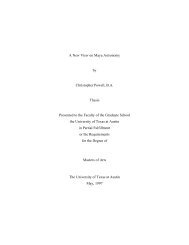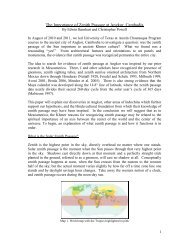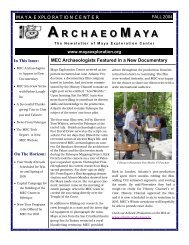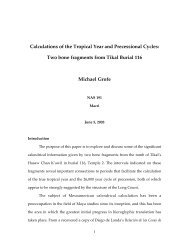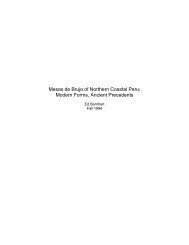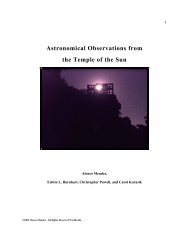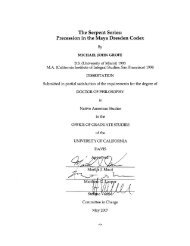Moises Morales Marquez - Maya Exploration Center
Moises Morales Marquez - Maya Exploration Center
Moises Morales Marquez - Maya Exploration Center
Create successful ePaper yourself
Turn your PDF publications into a flip-book with our unique Google optimized e-Paper software.
An Interview with <strong>Moises</strong> <strong>Morales</strong> <strong>Marquez</strong>Pilot, farmer, naturalist,explorer, <strong>Moises</strong> <strong>Morales</strong> <strong>Marquez</strong>has led many unorthodox lives. Hispassion for the <strong>Maya</strong> led him intothe jungle, and to lifetimefriendships with the Chol andLacandon. He cleverly sidesteppedpositions at universities, thepressures of publishing, and theworld of college degrees. Yet fewscholars have made so great animpact on our understanding ofPalenque. As Palenque’s first guide,he played an enormous role inincreasing awareness of the ruins. Host of the first three Palenque Round Tables, patientarchaeoastronomer long before that field of study was born, Don <strong>Moises</strong> has been at theforefront of new ideas for 50 years. His intellect, philosophy, and willingness to sharehave affected people on a global level. <strong>Moises</strong>’ wisdom and advice inspired theconception of MEC’s mission, and we are proud to present some of his stories andthoughts here. Carol Karasik’s interview with the 80-year-old raconteur was conductedon his forested land, El Panchan.July 16, 2005MM: I was born in Mexico City in 1925, but after World War II, I moved to Sonora. Iwas an aviator and went to Sonora to start a farm in the desert. I lived in the desert foreleven years. We had success, but thanks to the change in prices for cotton, we losteverything. And so we had to search for another place to farm. That is how I came toPalenque. When I was in the Air Force, I flew over Palenque and saw a white spot on themountain. “What it that?” I asked my commander. He told me to look at the map. “It’sthe archaeological zone of Palenque, idiot!” I never thought that I would live near thatwhite spot on the mountain. My coming to Palenque was totally fortuitous.We were from the north and not at all like the people of Chiapas. There was alwaysanimosity between us. There were no professionals living in Palenque, only cattleranchers from Emiliano Zapata. The place was full of ignoramuses.Despite the unfriendly people, I decided it was a good place to stay. The village wasbeautiful, the nature was exceptional. And there was a possibility that with my littleEnglish I could be a guide. There were no guides, just one boy called El Tigre, whoplayed the role of guide. He knew how to walk quickly across the grass from one templeto the other. At the time there were no trees in the ceremonial center. There was a littleorange tree on the southwest corner of the Palace where the tourists could sit in the shade.But there were no ceibas or big trees by the North Group. There was nothing but1
than 1000 pyramids, 1000 structures? Why do you have to tell all these lies? When theygo back home they are going to discover that you are a liar.”I said, “Well, if you have some questions that I can answer, I will tell yousomething that perhaps will surprise you.” He asked me three questions. And I said,“What a pity that you have no time to listen. But I can show you some things that willanswer your questions, and I promise you that I will not have to say one word and youwill be completely convinced.” So he accepted the challenge, delivered some papers,organized the direction of the show, and returned. We went to the jungle. I showed himthe places, showed him, without saying one word, that he was completely wrong, asmany archaeologists then were wrong, and when I finished with the three subjects, wewalked back to the ceremonial center. He was quiet. He checked his watch and then wewent to sit under the shade of the almond tree.“I am convinced that I have nothing to say to you about the archaeology ofPalenque,” he said. “This is my last talk with you about it. What you showed me isenough, and let’s change the subject. You know my son, Donald?” I didn’t know he had ason. “Well, he’s an archaeologist, but he’s in Peruvian archaeology.” “Why not the<strong>Maya</strong>?” I asked, and he said, “I should prefer to have a mason in my house than to havean archaeologist in the <strong>Maya</strong>. I can’t tolerate the archaeologists of the <strong>Maya</strong>.”He paused, as if he were listening to some celestial music. “Do you hear that?” hesaid. “It’s the Patetique,” and then he mentioned the “great deaf one.” If you know a littleabout music, you know that Beethoven was deaf when he wrote the Fifth Symphony, andif you put together these things, then of course it was the Fifth Symphony that Thompsonwas listening to in his mind. Then he talked about Temple IV at Tikal and compared thetemple with the music, step by step, and he made me feel that the temple was a symphonyor the symphony was a temple. I was in a dream.“You admire the French,” he said. “The frogs.”“Yes,” I said. “But they call you English the beefeaters. I don’t like beefsteaks,and I don’t eat the French, so I’m neutral.”“Do you think the French are romantic? Well, you have to know the Russians.When you know the Russians, you discover true romanticism.” Then he asked me what Iknew about Yaxchilán and the lintel that was burned. They say the lintel in Temple 39caught fire when the ancient people were burning the limestone used in preparing maize,and that is the reason the temple fell. “But it was a cannonball,” Thompson said. “It wasTchaikovsky’s 1812 Overture, and the cannonball broke the lintel of Temple 39!” He wasreally strange.“And when you see Palenque, when you see the Temple of the Sun from theFoliated Cross, it’s like embroidery, it’s like lace, but it’s also music. It’s Mozart,” andthen he started to talk about Mozart and the Temple of the Sun converted to music. I likedMozart, but I disagreed. I said, “I have not the same taste as you. For me it is somethingelse.”Sometimes I used to orchestrate a little farce, to motivate the tourists, people whoknew music. One morning I was with some friends from the Smithsonian Institution atsix A.M., and we were standing in the Temple of the Foliated Cross, waiting for the sunto touch the roofcomb of the Temple of the Sun. I had an assistant go inside the templewith a tape recorder, and the moment I raised my hand, he played a tape of Vivaldi’sConcerto for Birds. The natural birds that were singing were confused by the sounds of3
those strange birds coming from the temple. They went crazy and started to sing louder,because that was their territory. You should have seen the faces of the people! They weredeeply touched by the music, by the birds, by the sun rising over the mountain, and thelight moving like a horizontal curtain across the swamps of Tabasco, and then, like avertical screen dropping down, the sun touched the roofcomb and showed the beauty ofthe temple. That was really great.“Perhaps if you play some other music, it would not be as good as what happenedthat day, ” I told the gentleman. I paused, sure that I had won the round. “But when therain starts coming from the south, as happens in Palenque, the mist will bring out thethree-dimensional shape of the temple, the dead, dry stones will be shining, and by magic,the temple will come alive. At that moment you’re not going to play birds, because thebirds will have their wings wet, and it will be impossible to listen because of the noise.Then you have to take from your imagination a harpsichord and play some music of Bach,and that will fit exactly.“But in summer, the season of the long days, the rain disappears, and what wehave left are incredible clouds, high cumulus at 16,000 ft., with the sun behind, and it isso spectacular that the size of the temple diminishes and the great thing is the sky, theincredible show of the clouds, and the light that strikes the dust in the atmosphere andproduces the beautiful colors of the sunset. It is not for playing the Concerto for Birds, itis not for a harpsichord. You have to play something strong, something motivating, andwhat better than Telemann’s Festival for Metals, loud, explosive, something that willchallenge the clouds.”“All right,” he said, “That means we are not even going to talk about music.” Oneyear later, we had the unfortunate news that he died in California.CK: What was your personal interest in Palenque?MM: Sociology. People thought I was interested in the archaeology, but I was interestedin people. But why did I choose Palenque for that? Because Palenque is a magic mirror,Palenque reflects you. If you are miserable, you will see miserable Palenque. If you are apoet, you will see a poetic Palenque. Palenque is a state of mind. Palenque will always bethe way that you reflect it. So you have to be proud when you see a beautiful Palenque,because that means your soul, your spirit, is really that size.I don’t believe in archaeology. I knew the greatest archaeologists. I saw their doubts, Isaw their miseries, and I didn’t like that. But I loved the people who were falling in lovewith Palenque, who were crying in front of the Temple of the Foliated Cross. They didn’tknow why it drew their tears, but it touched them deeply. That was the Palenque that Iwas in love with. It was not the Palenque of the guards showing you their potency, thearrogance of the archaeologists, of the administrators. No, that was the garbage of theplace. But you can always convert the garbage into beautiful things. So, Palenque is abeautiful lesson for a human being who knows how to enjoy life.CK: How does the new generation of scholars and archaeologists compare to the oldergeneration?4
and the seasons and the cycles of the moon across in the sky. It’s a lie that all that isdifficult. What you have to have is good wits in your head.CK: And now we have thousands of people who believe the <strong>Maya</strong> possessed profoundsecrets about the universe.MM: People will buy anything. The problem is that because of the lack of knowledge itwas easy to idealize the <strong>Maya</strong>. When archaeologists began to learn more, through bettertechniques, better instruments, and better ways of analyzing the findings, they realizedthey had to be idiots to idealize the <strong>Maya</strong>. The <strong>Maya</strong> were not the first inventors of thezero, for example. Thompson, Morley, all of them said the same thing. But all of themwere wrong, and all of them were part of the same mistake. Now you have to take thehand of your child and say, “I’m sorry about what we did, we are asking you to be honestwhen we were dishonest. Please accept my mistakes and let me go with you and help youto discover what was. I will help you to self-educate yourself and then you will put me onthe proper level.” That way we will have a stronger education. Never with thepontification of the one who made a mistake, but earned a good salary and achievedprestige and now wants to have that for eternity. If it was not enough, he wants to use hischildren to continue his grandiosity. That is the perfidy of most of the scholars.CK: Of all the people who came to Palenque, who was the person most interesting to you?MM: What a difference in subjects. My favorite story is about the sister of someone whowas considered a traitor to his people, King Leopold of Belgium. He was a collaboratorof the Nazis. Little by little, he is recovering his prestige; now it’s said he was doing it tosave his people from the destruction that would be almost total for such a small country.Leopold had a sister called Maria Joseph, and Maria Joseph was married to the last kingof Italy, Victor Emanuel. Mussolini was already in power and the king was just adecoration. The king came to Palenque. He was a nothing with a crown. And he wasworth nothing. He was not a strong character, he was not a good artist. He was just apuppet. He was invited by some of the rich to come and invest in a big hotel in Palenque.Because he went back to Europe with a good impression of Palenque, his wife decidedshe would come one day. After Victor Emanuel died, she accepted the invitation of herson-in-law, an Argentinian, to visit Palenque. That’s when I met Maria Joseph. She hadspecial permission to be at the ruins after they closed, because she wanted to make a quiet,humble visit. I was with a group of French when I saw the lady walking behind theArgentinian. He was looking for me. “I’m Luis,” he said. “I’m from Argentina, marriedto one of the daughters of that lady, who is the last queen of Italy. We would like you tohelp us a little, because she wants to enjoy the ruins in quiet.” So I went with them.That night I was having dinner with a group of friends at the Hotel Palenque, andwe decided to go out to the ruins to watch the moment when Mars reached the closestdistance to our planet in 300 years. We were very excited to go to a place where no doubtthe <strong>Maya</strong> had observed the same thing. We would repeat that moment, sitting on thegrass, thinking and watching, among the lonely monuments.The lady was having dinner at the same restaurant, and I went to say hello. Sheasked me why my pals were getting together, and I told her we were going to the ruins.6
“May I go with you?” she asked, and I said, “Oh, it will be very uncomfortable to beleaning in the grass. We’ll just see the same reddish light. That won’t change at all. Butwe have the chance to be in a place where perhaps somebody did the same thing athousand years ago.”She said, “I would appreciate very much if you can convince your friends to takeme. I will not create any problem.” Then she turned to Luis and told him, “I don’t knowhow you are going to manage, but I’m not going to have dinner. I’m going with thatgroup of people to lie down in the grass to view the approach of Mars.”So we went to the ruins to watch the red star. We were checking the chronometer,sitting and watching, full of warm emotions, nothing to be published, nothing to beannouncing. And the moment that Mars was the closest to this planet, our dreams wereflying toward him as we sat together, quietly watching on the dark grass in front of thePalace.The next day the queen was taking a plane from Villahermosa. I also had to go toVillahermosa, to speak to a convention of 400 dentists from all over the world, and thequeen said, “We’ll be very happy to have you in our car.” I accepted her offer, but toldher that I was on duty at the ruins and if I wasn’t back home by a certain time, then shemust leave without me. I went to the ruins and finished one hour late. I said to myself,“Well, it would have been nice to go to Villahermosa with the queen, but no way.” I wentback to the house and saw the car parked outside. It was unbelievable. “Sorry, but we hadto wait for you,” they said.We drove as fast as we could, only to see the tail of the plane leaving. There wereno rooms available, because of the convention. I searched for a place and finally foundone little room in a very, very cheap hotel. That was our only chance, because themanager was my friend. And the lady agreed to stay in that little piggy place. They wentto have something to eat and I went to check on my group. The tourist director saw meand said, “Do you know if the queen of Italy is in Palenque? She doesn’t want anyprotection, but the governor here has to be checking to see if everything is going well.” Itold him she was in the hotel, room 26, in Villahermosa. “Oh, but we have a space at theOlmeca,” he said. That was the very finest hotel. “And we had to put a family in thebeauty parlor to make room for her.” We went to see the queen, who was eating fish in alittle restaurant, and the tourist director told her about the room. She said, “I’m sorry, Icannot defraud the beautiful person who gave me a place. I’ll stay there.” Now that’sclass.CK: We ask this question of everyone. Where do you think Kan Balam is buried?MM: I don’t think the exploration of the Temple of the Cross is finished. In thenineteenth century, Count Waldeck made a drawing that showed a waterfall comingdown from the northwest corner of the Temple of the Cross. Everyone laughed at thedrawing, because the vegetation looked like Martian vegetation. Of course, he was notused to painting plants like that. But the waterfall, that was too much. We said that themosquitoes had produced his insanity. But when Christopher Powell was working withmy son Alfonso <strong>Morales</strong> on the Proyecto de las Cruces, he found that there was reallywater in that corner at that time. For sure, that was the place. It faced the little plaza thatwas constructed on the south side of the Palace. The area was nothing but water, and it7
you’ll find nothing.” She said, “But I want to do it, and it will cost nothing, we’re alreadyhalfway. I want to go to the floor of that inside temple.” She found the floor and shefound the tomb. There were big pieces of jade, square pieces of jade—they’re in themuseum —and the most beautiful piece found in Palenque, a jaguar head with an openmouth that framed the face of the ruler. It was the tomb of the Red Queen, and it was agreat find.The only thing that the men found was a big pile of rocks, the pointed rock at thebase of the Temple of the Sun and the big boulder under the Temple of the Cross. Therewas nothing else.9



